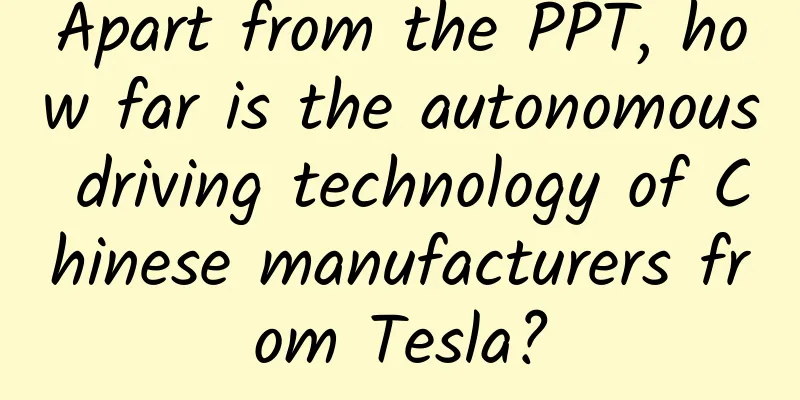Apart from the PPT, how far is the autonomous driving technology of Chinese manufacturers from Tesla?

|
He Zong The news that Baidu was going to make driverless cars triggered a Weibo joke frenzy. After all, in the past few years, whether in terms of market value or reputation, "B" has been left further and further behind "A" and "T". At first, everyone thought that this was either a completely wrong image self-rescue action or another C2C (Copy to China) incident.But now it seems that Baidu is serious. At the Shanghai Auto Show in April this year, Baidu revealed its Apollo Project, announcing that it had established partnerships with BAIC Group, Chery and others to jointly develop autonomous driving and would open up the technology in phases. Sure enough, in July, Baidu open-sourced part of the Apollo program code on GitHub as promised. But this open source code has been controversial after its release. First of all, this is not the "driverless car operating system" that Baidu said at the press conference. The whole is still based on the open source ROS (Robot Operating System). After the passionate presentation at the press conference, a modified version of the open source software was brought out. Although it is impeccable, it is still a bit disappointing. Baidu has said that its vision is to become the Android of driverless cars, to occupy the market through open platforms, and then to collect big data to further extract value. But it is hard to say whether this can be accomplished, because Baidu has almost no control over hardware. It is true that Google has collected a large amount of user data with the help of Android and then used it to sell advertisements, but it also has to face the dilemma of the fragmentation of the entire Android market. The degree of hardware fragmentation in cars is much higher than that in mobile phones. It is hard to say whether it is a good idea to try to replicate the idea of Android in such an environment. Google probably thinks not. Their Waymo team has always been a major customer of Velodyne, but recently Waymo's vision system and lidar have been switched to internal independent research and development. Waymo, which also provides autonomous driving solutions and combines software and hardware, undoubtedly seems to be more confident. Another embarrassing question is whether it is too late for Baidu now. Tesla released the first version of Autopilot in 2015. As of July this year, it has accumulated up to 8 billion kilometers of operating data, and is still growing at a rate of 1.6 billion kilometers per quarter. For the neural network algorithm used in autonomous driving, the quality of the algorithm itself is important, but a large amount of data accumulation, optimization, and training are more important. This is a positive cycle of more user data - good product experience - increase in the number of users - further collection of more data - further improvement of product experience. Tesla, which took the initiative, has already run such a long distance. It is probably difficult for Baidu to catch up with its current progress. However, the recently released Baidu Apollo 1.5 seems to have brought a turnaround. It further opened up several modules such as high-precision maps, environmental perception, decision-making and lidar support. Compared with version 1.0, Apollo Project 1.5 is undoubtedly more powerful. In particular, the addition of lidar makes the entire platform more professional. At present, in terms of autonomous driving research, the indispensability of lidar is almost a consensus in the industry (except Tesla). It can be said that with lidar, Apollo has truly entered this circle. However, lidar also brings new practical problems. Velodyne, Baidu's designated LiDAR supplier, announced at the beginning of the year that it would reduce the price of LiDAR to US$50 and produce one million LiDARs annually, but current LiDARs are still expensive and scarce. Although Baidu promised that partners joining the Apollo program could get lidar at a faster delivery speed and more favorable price, this promise still seems to mean "we are out of stock now." In addition to lidar, Baidu also provided a reference hardware platform, detailing the recommended selection of components including satellite positioning modules, on-board computers and even power supplies, all provided by third-party manufacturers. In the IPC part of the core hardware, we see the specifications of TITAN X + E3-1275. Readers familiar with PC hardware should know that this combination represents a very strong computing power. In other words, such a huge computing power requirement seems to indicate that the current optimization level of the Apollo vehicle system is still insufficient. The car manufacturers on the other side also have their own actions. Lianheng Also in 2013, BYD signed an agreement with Beijing Institute of Technology and spent more than three months to produce an autonomous driving test car equipped with laser radar technology, and won the championship of the national driverless car driving competition that year. The following year, they announced that they had successfully established a connection with the Communications Research Institute of the Agency for Science, Technology and Research of Singapore. With a test car, achievements, and going abroad, BYD's autonomous driving research and development path has been quite independent. Then two interesting things happened. The first one is naturally the sudden disclosure by BYD Chairman Wang Chuanfu in early 2016: BYD's autonomous driving is not only being developed by itself, but also in cooperation with Baidu. Second, in June, news reports said that BYD and Zhejiang Zhonghe Technology had started in-depth cooperation in the field of "driverless driving". BYD quickly explained that the cooperation with Zhonghe Technology was limited to rail transportation and had nothing to do with driverless cars. BYD's goodwill towards Baidu may be more due to its urgent need for high-precision maps. It should be noted that although hardware such as LiDAR is important, its detection range is limited after all. When facing sharp bends, slopes and other road conditions, the limitation of detection distance leads to a decrease in reaction time and safety. Therefore, for autonomous driving, high-precision maps are a powerful weapon to face complex road conditions. In April this year, Baidu, AutoNavi, NavInfo and Bosch teamed up to do the Chinese version of high-precision map crowdsourcing surveying. In China, map surveying activities must first obtain the corresponding qualifications and be issued a license before they can be carried out. This cooperation lineup incredibly brings together the three largest of the 13 qualified Internet map surveying companies in China. BYD is not among the companies awarded a mapping license. From this, it is not difficult for us to understand why BYD quickly clarified its cooperation with Hozon Technology on driverless cars. Software and hardware can be purchased and developed by oneself. But if there is no license, there is really nothing. If BYD does not choose to cooperate, it will have almost no other way to obtain high-precision maps without a mapping license. Of course, there are also technical routes that do not require high-precision maps, but they are contrary to the mainstream route of almost the entire industry. I wonder if BYD has the courage to do so. The road ahead is long and difficult Domestic self-driving cars are still not on the road. This is a good thing. As a durable product, automobiles have a slow hardware upgrade. Latecomers can focus on better hardware and have the potential to catch up quickly. Moreover, there is still room for imagination before the car is launched. On the other hand, it is also a bad thing. As mentioned earlier, the AI training involved in autonomous driving requires a large amount of data to support it. Under the circumstances of similar algorithm levels, it is undoubtedly the one who sees more will run faster. If Baidu succeeds in the merger, it may be able to bring its own AI training volume close to Tesla's level in a short period of time, but it is still difficult to say how much control Baidu has over the Apollo project. Now, domestic companies are all standing in line, promoting, and showing off their concepts. They are too impatient. In Baidu's demonstration in July this year, their self-driving car still violated traffic rules by crossing the solid line, and even seemed to be unable to correctly identify lane markings. Such a platform claims to help a number of domestic manufacturers complete the research and development of self-driving models, but its persuasiveness is questionable. Another problem is that everyone is too "soft". Autonomous driving requires far more than just algorithms and operating systems. Higher-precision, higher-line-count LiDARs, better-penetrating millimeter-wave conventional radars, better cameras, and more powerful, lower-power-consuming onboard computers. These hardware development trends are impossible for everyone to ignore. At present, Baidu's only move on hardware seems to be investing in Velodyne. Domestic car companies have no moves related to self-developed hardware. How Baidu will deal with the high adaptation costs that will inevitably come with the fragmentation of hardware platforms, and how car companies will ensure a unified and good user experience. Now they all need a little "hard" strength. Furthermore, autonomous driving essentially puts the safety of passengers' lives and property in the hands of the vehicle itself. Can we trust domestic driverless cars? Although such concerns are just a joke, they are not entirely unreasonable. There is a saying in the software industry: "Talk is cheap, show me the code." Perhaps putting the ecosystem and platform aside and first producing a qualified self-driving car is the correct public relations approach for this circle. As a winner of Toutiao's Qingyun Plan and Baijiahao's Bai+ Plan, the 2019 Baidu Digital Author of the Year, the Baijiahao's Most Popular Author in the Technology Field, the 2019 Sogou Technology and Culture Author, and the 2021 Baijiahao Quarterly Influential Creator, he has won many awards, including the 2013 Sohu Best Industry Media Person, the 2015 China New Media Entrepreneurship Competition Beijing Third Place, the 2015 Guangmang Experience Award, the 2015 China New Media Entrepreneurship Competition Finals Third Place, and the 2018 Baidu Dynamic Annual Powerful Celebrity. |
Recommend
17 "hype methods" to promote your product
What I’m going to teach you today is not some cro...
Artificial Intelligence in AR
In March this year, the Shanghai Municipal Commis...
From Pechoin to Momo, is soft advertising better or hard advertising?
From Pechoin to Momo, with the same budget and th...
How much do you know about data operations?
Generally speaking, data is the most authentic wa...
Will 5G phones turn back to 4G? Possibly
At the press conference of the State Council Info...
HTC has formed alliances with the industry's top allies. Will the VR drama be played from top to bottom?
On December 18, the HTC Vive Developer Summit was...
Is there no place for medical soft-text promotion anymore? Sogou follows Baidu in launching a big move!
Following Baidu's release of the " Notic...
The ninth episode of the Aiti Tribe Clinic: Java, Python, PHP, they all say they are simple
【51CTO.com original article】 Activity description...
Is the solar system dark? Scientists have just discovered three "planet killers," one of which poses the greatest threat to Earth
Astronomers have discovered three near-Earth aste...
The supply of double points is less than the demand in the first transaction. BYD makes more money selling points than selling cars.
As soon as the corporate dual-points calculation ...
Leading by example and dedicating oneself to the country: In commemoration of the 99th anniversary of Deng Jiaxian's birth
Deng Jiaxian was a famous nuclear physicist in my...
What celestial bodies can be seen through a telescope? What do they look like?
Once upon a time, looking up at the stars was one...
Row-based waterfall view
Source code introduction The demo shows a row-bas...
Case analysis of information flow promotion in the automotive industry
As an information flow person in the automotive i...
"Four first-class equipment" and "three best in the same class" The configuration table of the powerful Internet SUV Roewe RX3 is released
Today, SAIC officially released the configuration...









